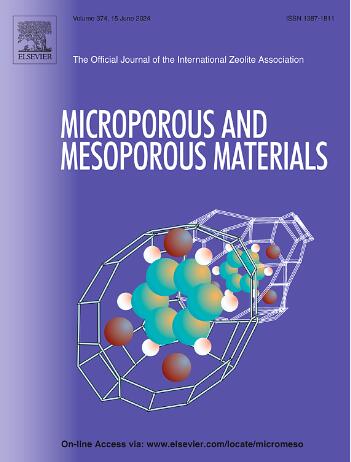Structure-directing effects of tetraalkylammonium cations in the interzeolite transformation of zeolitic MWW-type nickel silicate
IF 4.8
3区 材料科学
Q1 CHEMISTRY, APPLIED
引用次数: 0
Abstract
In this study, we successfully synthesized RUT-type and cristobalite nickel silicate materials by using tetramethylammonium (TMA+) and phenyltrimethylammonium ions (PTMA+), respectively, through the interzeolite transformation of the parent MWW-type nickel silicate (Ni-MWW). Under hydrothermal conditions, the parent Ni-MWW gradually decomposed into amorphous nickel silicate and subsequently reassembled into RUT and cristobalite structures after 12 and 24 h of crystallization time, respectively. With increasing crystallization time, the framework Ni species were stabilized by converting intermediate Ni species into isolated Ni species, resulting in a more thermodynamically stable chemical state. During the interzeolite transformation process, we obtained well-dispersed Ni species within fully crystallized RUT and cristobalite structures, with Ni loadings of approximately 7 and 8 wt%, respectively. Here, we comprehensively discuss the structure-directing effects of tetraalkylammonium cations, which lead to variations in both crystallization and stabilization rates of framework Ni species through the interzeolite transformation of Ni-MWW. This includes the use of TMAOH and PTMAOH, as well as our previous studies on tetraethylammonium hydroxide (TEAOH), tetrapropylammonium hydroxide (TPAOH), and N,N,N-trimethyl-1-adamantammonium hydroxide (TMAdaOH).

四烷基铵阳离子在沸石型mww型硅酸镍分子筛间转化中的结构导向作用
本研究通过母体mww型硅酸镍(Ni-MWW)的沸石间转化,以四甲基铵(TMA+)和苯基三甲基铵离子(PTMA+)分别成功合成了rut型和方石石型硅酸镍材料。在水热条件下,母体Ni-MWW在结晶12 h和24 h后逐渐分解成无定形硅酸镍,并重新组装成RUT和方石沸石结构。随着晶化时间的延长,中间Ni种转化为孤立Ni种,使骨架Ni种稳定,形成更稳定的热力学化学态。在沸石间转化过程中,我们在完全结晶的RUT和方石沸石结构中获得了分散良好的Ni物种,Ni的负载量分别约为7%和8%。在这里,我们全面讨论了四烷基铵阳离子的结构导向作用,通过Ni- mww的沸石间转化导致框架Ni物种的结晶和稳定速率的变化。这包括TMAOH和PTMAOH的使用,以及我们之前对四乙基氢氧化铵(TEAOH),四丙基氢氧化铵(TPAOH)和N,N,N-三甲基-1- adamantamoh (TMAdaOH)的研究。
本文章由计算机程序翻译,如有差异,请以英文原文为准。
求助全文
约1分钟内获得全文
求助全文
来源期刊

Microporous and Mesoporous Materials
化学-材料科学:综合
CiteScore
10.70
自引率
5.80%
发文量
649
审稿时长
26 days
期刊介绍:
Microporous and Mesoporous Materials covers novel and significant aspects of porous solids classified as either microporous (pore size up to 2 nm) or mesoporous (pore size 2 to 50 nm). The porosity should have a specific impact on the material properties or application. Typical examples are zeolites and zeolite-like materials, pillared materials, clathrasils and clathrates, carbon molecular sieves, ordered mesoporous materials, organic/inorganic porous hybrid materials, or porous metal oxides. Both natural and synthetic porous materials are within the scope of the journal.
Topics which are particularly of interest include:
All aspects of natural microporous and mesoporous solids
The synthesis of crystalline or amorphous porous materials
The physico-chemical characterization of microporous and mesoporous solids, especially spectroscopic and microscopic
The modification of microporous and mesoporous solids, for example by ion exchange or solid-state reactions
All topics related to diffusion of mobile species in the pores of microporous and mesoporous materials
Adsorption (and other separation techniques) using microporous or mesoporous adsorbents
Catalysis by microporous and mesoporous materials
Host/guest interactions
Theoretical chemistry and modelling of host/guest interactions
All topics related to the application of microporous and mesoporous materials in industrial catalysis, separation technology, environmental protection, electrochemistry, membranes, sensors, optical devices, etc.
 求助内容:
求助内容: 应助结果提醒方式:
应助结果提醒方式:


